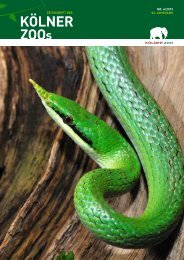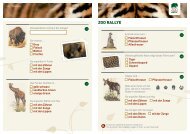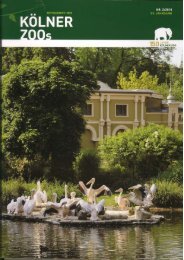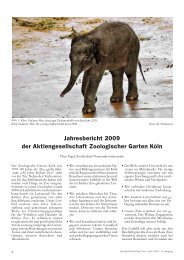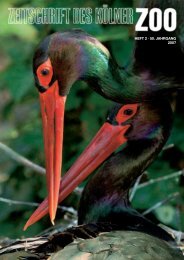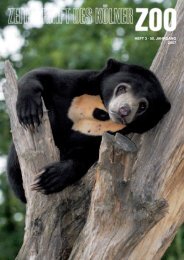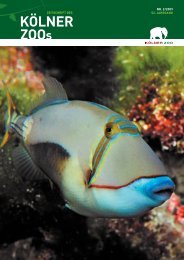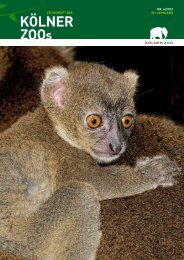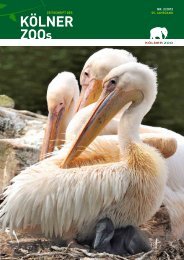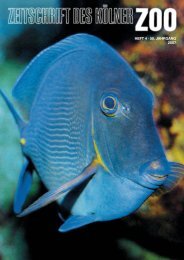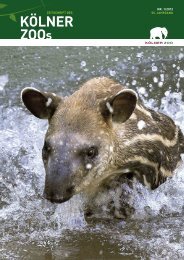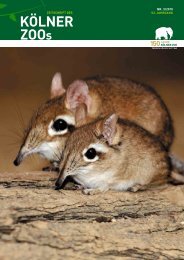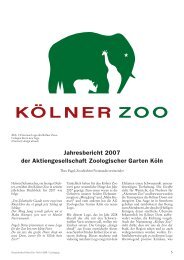Liebe Freunde des Kölner Zoos!
Liebe Freunde des Kölner Zoos!
Liebe Freunde des Kölner Zoos!
Erfolgreiche ePaper selbst erstellen
Machen Sie aus Ihren PDF Publikationen ein blätterbares Flipbook mit unserer einzigartigen Google optimierten e-Paper Software.
Abb. 48: Philippinenkrokodilschutz durch limitierte Auflage von Aquarellzeichnungen:<br />
Das erste in diesem Bericht abgebildete Foto <strong>des</strong> <strong>Kölner</strong> Philippinenkrokodilmännchens<br />
Pinoy stand Pate für diese Zeichnung, die nun für den guten Zweck verkauft werden soll.<br />
Philippine crocodile conservation through limited edition of water colour drawings: The<br />
first depicted photograph of the Philippine crocodile male Pinoy in this article was inspiration<br />
for this drawing which can be purchased for the good cause.<br />
(Zeichnung: R. F. Schmidt)<br />
Aquarium <strong>des</strong> <strong>Kölner</strong> <strong>Zoos</strong>, die wenige<br />
Tage später eröffnet wurde. Neben<br />
Informationen zum ersten EAZA-<br />
Transfer von Philippinenkrokodilen<br />
nach Europa sowie Details zu Planung<br />
und Bau der Anlagen hinter den Kulissen<br />
und im Schaubereich <strong>des</strong> <strong>Kölner</strong><br />
Aquariums werden im vorliegenden<br />
Artikel Informationen zur Biologie <strong>des</strong><br />
Philippinenkrokodils und erste Erfahrungen<br />
im Umgang mit dieser Art bereitgestellt.<br />
Die nun in Köln und den<br />
anderen europäischen EAZA-<strong>Zoos</strong> gehaltenen<br />
Philippinenkrokodile sollen<br />
künftig zum Aufbau einer europäischen<br />
Erhaltungszucht dieser von der<br />
Ausrottung bedrohten Art beitragen.<br />
Summary<br />
The husbandry and keeping of crocodiles<br />
has a long lasting tradition in the<br />
Aquarium of the Cologne Zoo, which<br />
has been proven by multiple breeding<br />
successes of Nile crocodiles (Crocodylus<br />
niloticus) and dwarf caimans (Paleosuchus<br />
palpebrosus) in the past four<br />
deca<strong>des</strong>. Facing the first transfer of<br />
Philippine crocodiles (Crocodylus<br />
mindorensis) in EAZA (European Association<br />
of <strong>Zoos</strong> and Aquariums)<br />
<strong>Zoos</strong>, Cologne Zoo decided to engage<br />
in a conservation breeding program of<br />
this critically endangered species. The<br />
140<br />
EAZA import of Philippine crocodiles<br />
into Europe finally was enabled by<br />
contracts between the respective European<br />
partner zoos with the Philippine<br />
government and the Krokodille Zoo in<br />
Eskilstrup, Denmark, who was responsible<br />
for the crocodile transfer.<br />
With the keeping of Philippine crocodiles,<br />
which are still owned by the<br />
Philippine government, the European<br />
partner zoos obligated themselves to<br />
support the Mabuwaya Foundation in<br />
San Mariano on the Philippine island<br />
of Luzon, thus connecting ex situ with<br />
in situ crocodile conservation activities.<br />
Because Nile crocodiles still occupied<br />
the crocodile exhibit in the<br />
Aquarium of the Cologne Zoo at the<br />
time of the import of the Philippine<br />
crocodiles, an in total 315 x 762 cm<br />
measuring, threefold divisible enclosure<br />
with additional water space underneath<br />
the land parts was built for<br />
the young Philippine crocodile pair<br />
behind the scenes of the Aquarium.<br />
When in May 2010 the Nile crocodiles<br />
were relocated to the new tropical<br />
house “Hippodom”, we measured,<br />
planned and invited tenders from July<br />
to October 2010, and subsequently<br />
started with the renovation of the<br />
old public crocodile exhibit in the<br />
Aquarium of the Cologne Zoo. By doing<br />
so, the old public crocodile exhibit<br />
was expanded by including a neighbouring<br />
terrarium, and former parts of<br />
the visitor’s area were added as two additional<br />
land parts. Due to a current<br />
confiscation of endangered yellowbanded<br />
Philippine water monitor<br />
lizards (Varanus cumingi), which had<br />
to be urgently placed in zoos, a facility<br />
for this species became integrated in<br />
the new Philippine exhibit at short notice.<br />
Instead of the old visitor’s barrier<br />
the new monitor lizard and crocodile<br />
exhibits are visible through a 22 m long<br />
and 2 m high new glass barrier, consisting<br />
of 10 double glazed windows.<br />
To keep the Philippine crocodiles,<br />
which tend to aggressive behaviour in<br />
captivity, species-appropriate and secure,<br />
two partitions were included in<br />
the public exhibit: On the one hand to<br />
separate male and female, on the other<br />
hand to subdivide the female enclosure,<br />
so that the keepers always have secured<br />
access to a crocodile-free part of<br />
the enclosure while cleaning. On<br />
2 nd May 2011 the currently only Philippine<br />
crocodiles in Germany – the<br />
161 cm long and 16.0 kg heavy male<br />
Pinoy and the somewhat smaller,<br />
153 cm long and 11.3 kg heavy female<br />
Mindo – entered their new ca. 62 m²<br />
large public exhibit in the Aquarium of<br />
the Cologne Zoo, which was opened<br />
several days later. Apart from information<br />
about the first EAZA import of<br />
Philippine crocodiles to Europe and<br />
details on the planning and building,<br />
both of the off-exhibit keeping and<br />
public exhibit in the Cologne Aquarium,<br />
we provide information on the<br />
biology of the Philippine crocodile and<br />
on our first experiences with the husbandry<br />
of this species in the present<br />
article. The Philippine crocodiles kept<br />
in Cologne and remaining European<br />
EAZA zoos are to be establishing a<br />
European conservation breeding program<br />
of this critically endangered<br />
species.<br />
Danksagung<br />
Wir danken dem Vorstand <strong>des</strong> <strong>Kölner</strong><br />
<strong>Zoos</strong>, Theo Pagel und Christopher<br />
Landsberg, für die stetige Förderung<br />
und Begleitung dieses über viele Jahre<br />
geplanten Projektes sowie dem Förderverein<br />
<strong>des</strong> <strong>Kölner</strong> <strong>Zoos</strong> für die großzügige<br />
Unterstützung <strong>des</strong> Baus der<br />
neuen Krokodilschauanlage im <strong>Kölner</strong><br />
Aquarium. Auch gilt unser Dank den<br />
Mitarbeitern der Zoowerkstatt (Wasseraufbereitung,<br />
Abwasserinstallation,<br />
z.T. Elektroneuinstallation, Sandbank-



